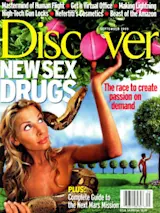Museum visitors seem to grow and shrink in the distorted environment of the Ames Room (left). Filtered through prisms and mirrors and projected on a large screen, a directed sunbeam paints vibrant pictures (right). Courtesy The exploratorium
When blind people come here, they say it's like everyday life," says Xavier Diaz, the attendant at the Tactile Dome, an 18-foot-tall geodesic structure tucked into a corner of San Francisco's cavernous Exploratorium. Sighted visitors, however, are unlikely to have experienced anything quite like it since exiting the womb. First they must hand over shoes, wallets, jewelry, eyeglasses, and anything else that might fall out or slip off. Then they step behind a curtain into a lightless world. Padded walls close in, steering unseeing occupants through winding passages, up steep inclines, and in and out of chambers with curved object-studded ceilings. The museum-goers crawl through holes that fit snugly around the hips; they ...














